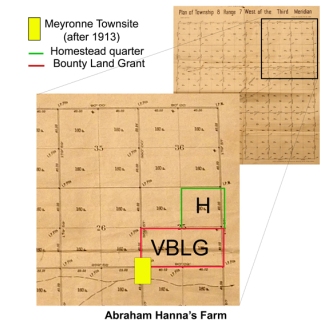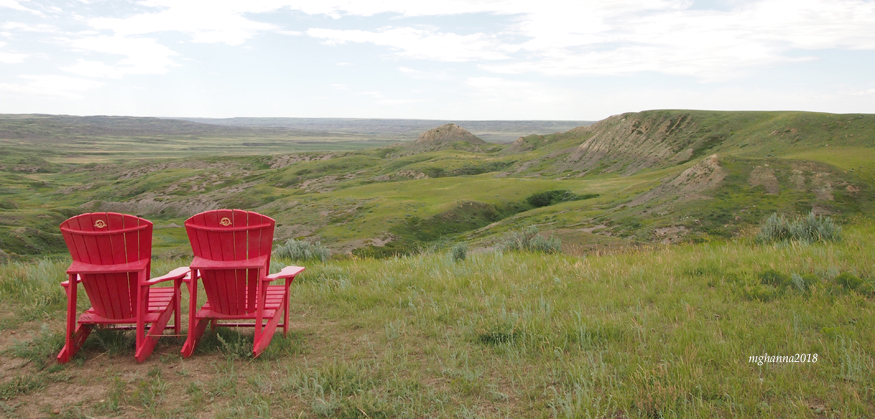When you’re a child, you don’t question how things are. You just assume that the way things are now is the way they’ve always been.
At least, I did. I assumed that the farm I knew, consisting of 1080 acres – the home section of 640 acres, most of a half-section (280 acres) to the west across the road, and another the quarter-section of 160 acres about ½ mile to the north – had always been in my family’s possession.
Boy, was I in for a surprise!
What follows are two stories in one: the story of how Abe – Grandpa Hanna – acquired all that land, and how I discovered the history of my family’s farm while researching for “Our Bull’s Loose In Town!” Tales from the Homestead.
In the beginning: Section 25, Township 8, Range 7, West of the 3rd Meridian
The Homestead Quarter: NE-25
I had always assumed that Grandpa Hanna had homesteaded the SW quarter of Section 25 because that’s where the farmstead was that I grew up on. So, imagine my surprise one day when I was walking across the section (looking for arrowheads, naturally) and discovered a scatter of glass and ceramic fragments and other historic debris on the far east side. I mentioned this to Dad when I returned to the house.
“Oh, that’s where the homestead house was,” he told me. “Mom and Dad lived there for several years before they moved over here.”
Really?
A few years later, I was at the Regina office of the Saskatchewan Archives Board looking up information about an archaeological project I was working on, when I thought, Hmmm, why don’t I look up my grandfather’s homestead records while I’m here? I found not one, but three documents: one each for the NE quarter, the NW quarter and the S half of Section 25.
 Abe filed for his homestead quarter – NE-25 – one bitterly cold morning of December 29, 1908, at the Dominion Land Office in Moose Jaw. He had not chosen that area at random. All through 1908, when he was working for his great-uncle David Copeland who lived just north of Moose Jaw, he had explored the “south country” looking for land. What he acquired for his homestead was decent farmland, treeless, gently rolling, with a large slough on the north side and just north of a small, usually permanent, creek. He moved to the homestead in May 1909 and lived in a tent until he built a 12′ x 14′ shack and a sod barn. He also dug a well. That year, he broke 15 acres and cropped seven.
Abe filed for his homestead quarter – NE-25 – one bitterly cold morning of December 29, 1908, at the Dominion Land Office in Moose Jaw. He had not chosen that area at random. All through 1908, when he was working for his great-uncle David Copeland who lived just north of Moose Jaw, he had explored the “south country” looking for land. What he acquired for his homestead was decent farmland, treeless, gently rolling, with a large slough on the north side and just north of a small, usually permanent, creek. He moved to the homestead in May 1909 and lived in a tent until he built a 12′ x 14′ shack and a sod barn. He also dug a well. That year, he broke 15 acres and cropped seven.
He filed for the patent in February, 1912, by which time he had broken 70 acres and was cropping 50. He valued the house at $125.00, the stable at $100.00 and the well at $100.00.
That the homestead was the NE, not the SW quarter, was only my first surprise.
The “Script” Land: S-25
 The second archival document threw me for a loop. It was entitled “Volunteer Bounty Land Grant.”
The second archival document threw me for a loop. It was entitled “Volunteer Bounty Land Grant.”
A Volunteer Bounty Land Grant? What was that?
The archivist found a leaflet that gave me the answer. The Land Grant entitled veterans of the Boer (South African) War to 320 acres, although they had the option of receiving a cash payment of $160.00.
Abe was a veteran of the Boer War? That was news to me. It was also news to my father when I asked him about it. His response: “Dad never mentioned anything about that.”
I contacted the Public Archives and Library of Canada in Ottawa to see if they had a record of one Abraham Hanna volunteering in the Boer War. Their reply was they had no record of such a person, although they admitted that their records from that war were spotty, at best.
The puzzle remained unresolved for a few years until we opened up Grandma Hanna’s trunk in 1998. There, amongst all the many farm documents and photographs, were three documents that explained how he had acquired the land.
The first was a form from the Dominion Lands Office, Ottawa, acknowledging that a Mr. Robert Thomas Lowes of Carberry, Manitoba, had sold his Bounty Land Certificate to Abraham Hanna. It was dated 9th June, 1909. There is nothing to record how much Abe paid Mr. Lowes. I suspect it was probably at least $160.00.
The next two documents are from the Dominion Lands Office in Moose Jaw and are dated 9th July, 1909. One certifies that Abraham Hanna applied for the south half of section 25 as a substitute for the grantee (the above named Robert Lowes). The other is the actual application for the land.
Abe’s obligations were now doubled for he had to “prove up” the south half as well as the NE quarter. That meant he had to break at least 10 acres a year AND live on the script land for at least six months each year – living on an adjacent homestead quarter did not qualify.
That first year, he broke 10 acres and built a larger frame house – 14′ x 24′ with two rooms – on the very north edge of the script land, just a few yards south of the homestead shack. In the summer, from May 8 to November 7, he lived on the NE quarter. On November 8, he moved a few yards south and lived on the script land until May 7. Thus, I maintain that Abe was one of the first “snowbirds.”
By 1912, when he applied for the patent, he had broken 60 acres and was cropping 30. He also had fenced 25 acres, valued at $50.00, as pasture for the livestock
The Pre-emption Quarter: NW-25
 Abe applied for the NW quarter of section 25 in August, 1909. He now had the entire section – 640 acres! He did not have to live on the pre-emption quarter, as he had to with the homestead quarter and the script land, but he had to break and crop at least 50 acres within a three-year time frame.
Abe applied for the NW quarter of section 25 in August, 1909. He now had the entire section – 640 acres! He did not have to live on the pre-emption quarter, as he had to with the homestead quarter and the script land, but he had to break and crop at least 50 acres within a three-year time frame.
Grandma Hanna’s trunk yielded one more surprise – Grandpa almost lost the NW quarter! He was so busy fulfilling the obligations on the rest of his land that he did not have time to prove up this quarter. He had finally bitten off more than he could chew.
The Dominion Lands Office in Moose Jaw caught up with him in April, 1914. Abe received a “Notice to Show Cause” from the Office stating, “you are not complying with the provisions of the Dominion Lands Act . . . and you are therefore required to show cause, within sixty days from this date, why the said entry should not be cancelled.”
If Abe was anything like my father, what he would have said upon reading this Notice would not be fit to print. The back of this Notice is filled with Abe’s notations summarizing what had occupied his time and why he had, as of yet, done nothing on the pre-emption quarter. No copy of his letter to the Lands Office exists but it must have been effective. On June 16, the Lands Office sent a reply: “I beg to inform you the cancellation proceedings pending against your pre-emption entry above described, will, in view of the statement submitted in defence thereof, now be abandoned.” It was signed, “Your obedient servant,” which, I am sure, gave Abe more cause to exercise his vocabulary.
That year, he broke 40 acres and cropped 32. In August, 1916, he applied for and received the patent for the pre-emption. The entire section – all 640 acres, minus the 40 acres in the far SW corner that the CPR had purchased in 1913 for the Meyronne townsite – was now his.
That should have been enough for one farmer back in the horse-drawn farm equipment days, shouldn’t it?
It wasn’t, at least not for Abe.
Next: Land Acquisition Continues
P.S. You can read about the challenges of “proving up” the homestead in Chapter 11 of “Our Bull’s Loose in Town!” Tales from the Homestead
#HannaFamilyHistory #Homestead History #MeyronneSaskatchewan #VolunteerBountyLandGrant #History #SaskatchewanHistory #Nonfiction #MargaretGHanna #HistoricalResearch #OurBullsLooseInTown

Wow! Love your style of writing. This was a joy to read, learning about some local farming and homestead experience!
LikeLike
thank you very much. glad you enjoyed it.
LikeLike